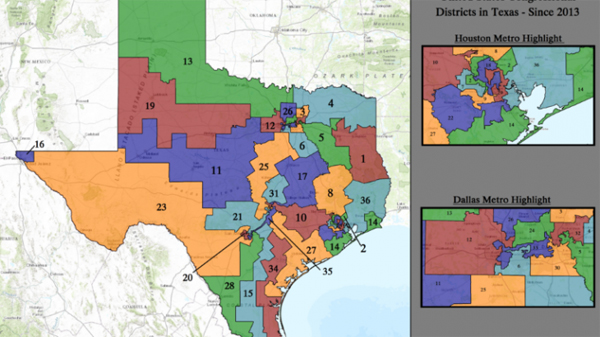- UTRGV Recognized By ED As Among Schools ‘Doing The Most To Lift Students Up’
- Halloween is a Tradition That Dates Back Many Years
- Esteban Cabrera – December 26, 1945 – October 11, 2024
- Ready for District
- Harlingen Opens First Pump Track in South Texas
- ACE Flag Football
- La Feria ISD Hires Chief of Police for District
- Three Ways To Protect Migratory Birds This Fall
- Goodwill and the RGV Vipers Team Up for a Skills Camp
- Santa Rosa ISD Offers Law Enforcement Cadet Program
Plaintiffs Want Texas Congressional Districts Redrawn for 2018
- Updated: April 7, 2017

A federal court recently ruled that Texas Congressional Districts 20, 23 and 27, as drawn in 2011, discriminate against minority voters and violate the Voting Rights Act. Photo: Wikipedia
by Mark Richardson
SAN ANTONIO, Texas – A group of plaintiffs is asking a federal court to force Texas to redraw the state’s current congressional district boundaries ahead of the November 2018 elections.
The three-judge panel ruled March 10 that Republicans had drawn three of the state’s congressional districts with the intent to discriminate against Latino and African-American voters.
Matt Angle, director of the Lone Star Project, a political research group, says the districts identified by the court were “torturously gerrymandered” to exclude minority voters, a process he calls “packing and cracking.”
“Republican leaders drew the maps in which they packed as many of those neighborhoods into as few districts as possible and then they cracked the rest of those neighborhoods into as many districts as possible in order to undermine their voting strength,” he states.
In its ruling, the court did not discuss any remedies to correct the problems. The plaintiffs’ motion seeks to order the Legislature to redraw the state’s current districts in time for the 2018 midterm elections.
Texas Attorney General Ken Paxton maintains that because the ruling pertains only to the 2011 districts, the court has no jurisdiction to order changes in the current boundaries, which went into effect in 2013.
However, Angle says the plaintiffs’ motion points out that when the Legislature redrew the districts in 2013, the three areas the court identified from 2011 were not substantially altered.
“Those districts are absolutely unchanged in the current map relative to the old map, and so you would think that the court would want to change those before we have another election,” he stresses.
The judges found that the three voided districts were drawn to minimize the impact of minority voters, particularly in Austin and San Antonio. He said one district, the 23rd, sprawls 500 miles from San Antonio to near El Paso, an area larger than many states.
“Current Republican leaders see the method for retaining their power long-term to intentionally discriminate against African-American and Latino voters, and the court has stepped in here to call them on the violations,” Angle maintains.
Plaintiffs in the case include the NAACP, Mexican American Legislative Caucus, League of United Latin American Citizens (LULAC), the Texas Latino Redistricting Task Force and several African-American and Latino members of Congress.


